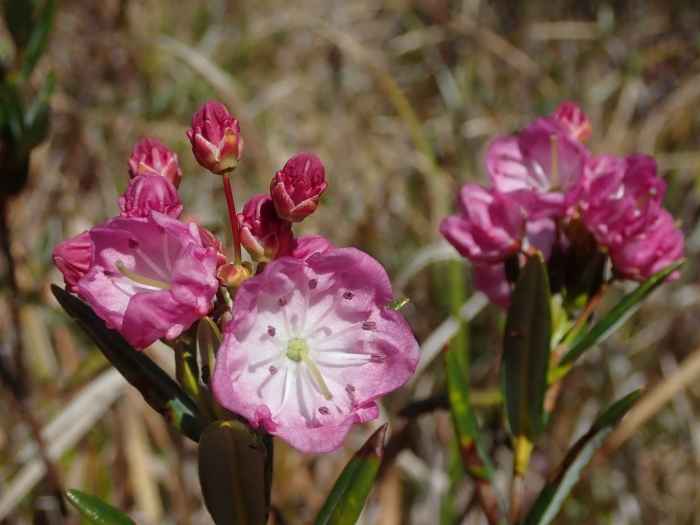Alpine Laurel
(Kalmia microphylla)
Alpine Laurel (Kalmia microphylla)
/
/

Nolan Exe
CC BY 4.0
Image By:
Nolan Exe
Recorded By:
Copyright:
CC BY 4.0
Copyright Notice:
Photo by: Nolan Exe | License Type: CC BY 4.0 | License URL: http://creativecommons.org/licenses/by/4.0/ | Rights Holder: Nolan Exe | Publisher: iNaturalist | Date Created: 2019-05-04T10:50:29-07:00 |


















































Estimated Native Range
Summary
Kalmia microphylla, commonly known as Alpine Laurel, is an evergreen subshrub or shrub native to mountainous regions, including subalpine zones, moist alpine meadows, and boggy areas in the Western United States, Western Canada, and Alaska. It typically grows to an average height of 24 inches (61 cm). Alpine Laurel is characterized by its small, leathery, dark green leaves and clusters of intricate, pink or purple, bell-shaped flowers that bloom from late spring to early summer. The flowers are particularly showy due to their unique structure; five fused petals form a cup shape, and the stamens within are spring-loaded, dusting pollinators with pollen when triggered. Following flowering, the plant produces small, hard, green fruits.
Alpine Laurel is valued for its ornamental flowers and compact growth habit, making it suitable for rock gardens, alpine collections, and as a ground cover in suitable climates. It thrives in acidic, peaty, or sandy soils with good moisture retention and requires consistent moisture, although it is somewhat tolerant of drier conditions once established. It prefers full sun to partial shade and is relatively low maintenance, but it can suffer from problems such as leaf spot and root rot if conditions are too wet. Gardeners should be aware that all parts of the plant are toxic if ingested.CC BY-SA 4.0
Alpine Laurel is valued for its ornamental flowers and compact growth habit, making it suitable for rock gardens, alpine collections, and as a ground cover in suitable climates. It thrives in acidic, peaty, or sandy soils with good moisture retention and requires consistent moisture, although it is somewhat tolerant of drier conditions once established. It prefers full sun to partial shade and is relatively low maintenance, but it can suffer from problems such as leaf spot and root rot if conditions are too wet. Gardeners should be aware that all parts of the plant are toxic if ingested.CC BY-SA 4.0
Plant Description
- Plant Type: Subshrub, Shrub
- Height: 1-1.5 feet
- Width: 0.5-1.2 feet
- Growth Rate: Slow
- Flower Color: Pink, Purple
- Flowering Season: Spring
- Leaf Retention: Evergreen
Growth Requirements
- Sun: Full Sun, Part Shade
- Water: Medium
- Drainage: Slow, Wet
Common Uses
Bee Garden, Bird Garden, Butterfly Garden, Low Maintenance, Rabbit Resistant, Showy Flowers, Water Garden
Natural Habitat
Native to mountainous regions, including subalpine zones, moist alpine meadows, and boggy areas
Other Names
Common Names: Bog-Laurel, Alpine Bog Laurel, Swamp-Laurel, Western Laurel, Western Bog Laurel, Kalmia À Petites Feuilles
Scientific Names: , Kalmia microphylla, Kalmia occidentalis, Kalmia microphylla subsp. occidentalis, Kalmia microphylla var. occidentalis, Kalmia polifolia var. microphylla, Kalmia polifolia subsp. microphylla, Kalmia glauca var. microphylla, Kalmia polifolia subsp. occidentalis, Kalmia microphylla f. alba,
GBIF Accepted Name: Kalmia microphylla (Hook.) A.Heller